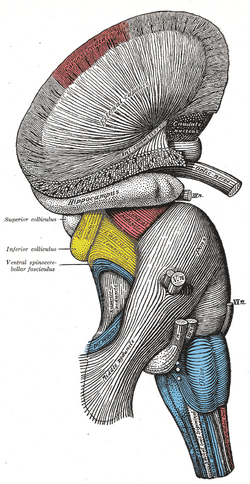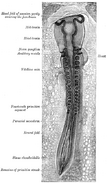Assessment |
Biopsychology |
Comparative |
Cognitive |
Developmental |
Language |
Individual differences |
Personality |
Philosophy |
Social |
Methods |
Statistics |
Clinical |
Educational |
Industrial |
Professional items |
World psychology |
Biological: Behavioural genetics · Evolutionary psychology · Neuroanatomy · Neurochemistry · Neuroendocrinology · Neuroscience · Psychoneuroimmunology · Physiological Psychology · Psychopharmacology (Index, Outline)
| Brain: Rhombencephalon | ||
|---|---|---|
| Diagram depicting the main subdivisions of the embryonic vertebrate brain. These regions will later differentiate into forebrain, midbrain and hindbrain structures. | ||
| Superficial dissection of brain-stem. Lateral view. | ||
| Latin | {{{Latin}}} | |
| Gray's | subject #187 767 | |
| Part of | ||
| Components | ||
| Artery | ||
| Vein | ||
| BrainInfo/UW | hier-531 | |
| MeSH | A08.186.211.132.810 | |
The rhombencephalon (or hindbrain) is a developmental categorization of portions of the central nervous system in vertebrates.
The rhombencephalon can be subdivided in a variable number of transversal swellings called rhombomeres. In the human embryo we can distinguish eight rhombomeres, from caudal to rostral: Rh7-Rh1 and the isthmus (the most rostral rhombomere).
A rare disease of the rhombencephalon, "rhombencephalosynapsis" is characterized by a missing vermis resulting in a fused cerebellum. Patients generally present with cerebellar ataxia.
The caudal rhombencephalon has been generally considered as the initiation site for neural tube closure.[1]
Myelencephalon[]
Rhombomeres Rh7-Rh4 form the myelencephalon.
The myelencephalon forms the medulla oblongata in the adult brain; it contains:
- a portion of the fourth ventricle,
- the glossopharyngeal nerve (CN IX),
- vagus nerve (CN X),
- accessory nerve (CN XI),
- hypoglossal nerve (CN XII),
- and a portion of the vestibulocochlear nerve (CN VIII).
Metencephalon[]
Rhombomeres Rh3-Rh1 form the metencephalon.
The metencephalon is composed of the pons and the cerebellum; it contains:
- a portion of the fourth ventricle,
- the trigeminal nerve (CN V),
- abducens nerve (CN VI),
- facial nerve (CN VII),
- and a portion of the vestibulocochlear nerve (CN VIII).
Additional images[]
See also[]
References[]
Human brain, rhombencephalon, metencephalon: cerebellum (TA 14.1.07, GA 9.788) | |||||||
|---|---|---|---|---|---|---|---|
| Surface anatomy |
| ||||||
| Grey matter |
| ||||||
| White matter |
| ||||||
| This page uses Creative Commons Licensed content from Wikipedia (view authors). |

